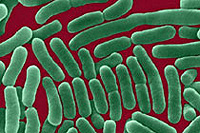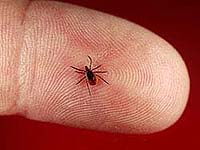Today, many know that botulism is a very serious disease that can be infected with canned food. What is the history of the opening of the pathogen of botulism and what about him know now? Read the Answers in the article.
Content
On December 14, 1895, a funeral was held in a small Belgian Place, after which 34 musicians of the orchestra were present on the acknowledged. The next day, a third of them got sick, and three died at the phenomena of hard poisoning. In order to investigate the circumstances of the infection, it was swollen that the cause of poisoning was ham. Two pieces of ham were salted at the end of the summer in a barrel, and poisoning appeared only in those who ate a hammer, which was in the depths of the barrel with brine.
Bacteriologist E. Van Ermenghem explored ham, and in that of them, which was the cause of poisoning, discovered sporing-forming sticks - Klostridia Botulism.
In the future, it turned out that there are several varieties of pathogens of botulism (A, B, C, D, E). The clinical symptoms of the disease caused by them are close, but produced toxins are different. Therefore, in the diagnosis and treatment of botulism, they use a set of relevant anti-cancer sera.
 What types of products serve the most common cause of botulism? The name of the disease comes from the word «Botulus», that in Latin means «sausage». This is due to the fact that for a long time, death poisoning has been associated with sausage products, mainly with blood sausage. Back in the 9th century, the German emperor Lion Wise forbade the manufacture of blood sausages due to frequent poisoning after their use, in food. In Russia, the diseases with the symptoms of botulism were often due to fish (balis, mostly sturgeon rocks). Therefore, such poisoning was called fish.
What types of products serve the most common cause of botulism? The name of the disease comes from the word «Botulus», that in Latin means «sausage». This is due to the fact that for a long time, death poisoning has been associated with sausage products, mainly with blood sausage. Back in the 9th century, the German emperor Lion Wise forbade the manufacture of blood sausages due to frequent poisoning after their use, in food. In Russia, the diseases with the symptoms of botulism were often due to fish (balis, mostly sturgeon rocks). Therefore, such poisoning was called fish.
The most important feature of the pathogen is that it forms disputes with exceptional resistance to external environmental factors, including high temperature. They can even withstand 5-hour boiling and die only at elevated pressure and temperature of 120 degrees (after 10-15 minutes of autoclaving). Therefore, with normal culinary processing and even with short-term excerpt in the autoclave, they can save viability.
In order to avoid saving dispute, the products of the canning industry are subjected to two-time autoclaving. After the first excerpt in the autoclave products are placed in thermostat conditions. During this time, the remaining viable disputes germinate in vegetative forms and are easily destroyed upon subsequent secondary processing.
In the described case of family poisoning canned food, repeatedly unstressed in the autoclave and therefore served as poisoning. However, it should be borne in mind that the toxin of botulism is destroyed at a temperature of 58 degrees for 3 hours and at 100 degrees (boiling) - less than half an hour.
At high temperature (80-100 degrees), the toxin is inactivated within a few minutes, while the vegetative forms of the microbe are dying. Such a product is relatively safe for consumption on the same day, although the disputes in it remain. The latter will germinate only within one or two days and then toxin will form again. Therefore, full thermal processing of products - warranty from most food poisoning.
It is also important to remember that Bacillus botulism is anaerobic, that is, develops only in the absence of air oxygen. That's why toxin is usually accumulated in the thicker of large bumps, baluster, sausages. That is why the reason for the poisoning of musicians and served as a lower slice of ham, to which the air penetrated less.
Everything that has been said to take into account both at home canning, for all conditions for the development of botulism bacillism are created in hermetically closed banks, if it penetrated there. It goes into products usually with soil particles, where it dwells constantly or where animal feces are made.
The pathogen of botulism is quite widespread in the soil, especially in the southern regions of the country. It is often found in the bottom of the seas and water bodies. This is explained by the fact that the microbe, being a saprophite, is able to multiply not only in a living organism, but also in a dead organic substrate. In the soil, it develops under conditions of heat and anaerobiosis (absence of oxygen) and remains for a long time in the form of dispute. This determines the epidemiological features of botulism.
Often the cause of botulism is plant products, in particular mushrooms, peas, beans, spinach, carrots, and t. NS. In the US, where the cans industry received a large development in the past century, botulism diseases after the use of canned vegetable products have been known for a long time. From botulism died, for example, one of the US presidents - Warren Garding.
 Nowadays, mass conservation of products is carried out not only in industrial, but at home. These are salting, and marinades, and jam. But if earlier - to the epoch of home canning - salt, vinegar or sugar were added to pickles and jams in large quantities, now in the presence of dishes and lids for hermetic packaging, the concentration of preservatives is reduced, they are added often only «For taste».
Nowadays, mass conservation of products is carried out not only in industrial, but at home. These are salting, and marinades, and jam. But if earlier - to the epoch of home canning - salt, vinegar or sugar were added to pickles and jams in large quantities, now in the presence of dishes and lids for hermetic packaging, the concentration of preservatives is reduced, they are added often only «For taste».
Therefore, with the slightest violation of the heat treatment mode, as well as the sterility of products and containers canned can be infected, including the pathogen of botulism. This wand can meet in mushrooms, tomatoes, eggplants, berry compotes, where it penetrates with soil particles. Especially dangerous canned food in large containers. D. AND. Drankin described a big outbreak (14 people poisoned) botulism, the reason for which mushrooms were, «Sounded» In a three-liter bank.
It should be remembered that there are no special signs of deterioration in products containing botulism toxin, usually does not happen. Only sometimes it is possible to notice the burnt odor and taste, loose consistency of products. Bombing of canned goods struck by clostridy botulism is not always found. Most often, poisoning occurs when used, it would seem impeccable for external signs of products.
Therefore, alertness is needed against the slightest signs of botulinum poisoning. Hidden (incubation) period of the disease, namely the time that passes from the moment of use of a dangerous product before the first signs of the disease, hesitates from several hours to several days. Early appeal to the doctor with complaints of malaise (vomiting, pain in the abdomen, impairment of vision, difficulty swallowing, constipation, difficult speech) is extremely important for timely assistance.
For treatment there are anti-cancer serums, the use of which is the effectiveity than before they are introduced. If in the family or in a circle of friends, together with which a suspicious product was used, someone complains about such symptoms of the disease, it is important to quickly report this to the doctor. This is necessary in order to identify and remove a common for the affected product for affected products.
Remember that botulism is a dangerous disease that, with late recognition and treatment, ends with death in 20% of cases, that is, every fifth of the victims! Be careful at home canning products and attentive when the first symptoms of the disease resembling botulism appear!









